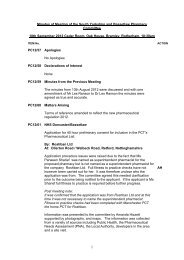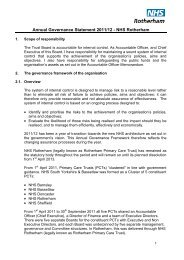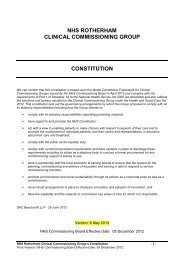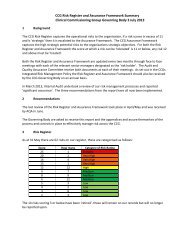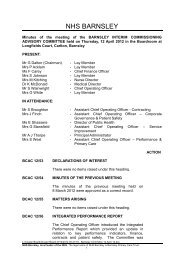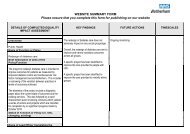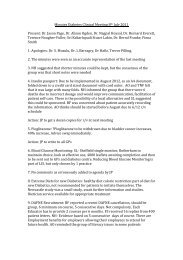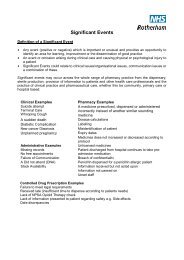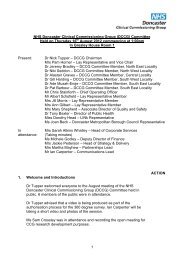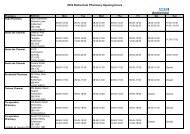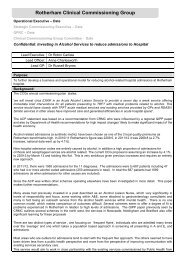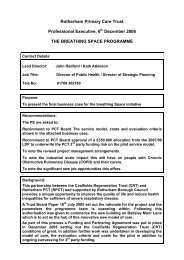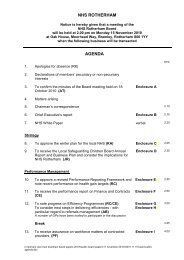Patient Group Direction (PGD) for - NHS Rotherham
Patient Group Direction (PGD) for - NHS Rotherham
Patient Group Direction (PGD) for - NHS Rotherham
Create successful ePaper yourself
Turn your PDF publications into a flip-book with our unique Google optimized e-Paper software.
This document expires on 20.3.15<br />
<strong>Patient</strong> <strong>Group</strong> <strong>Direction</strong> No VI 4<br />
<strong>Patient</strong> <strong>Group</strong> <strong>Direction</strong> (<strong>PGD</strong>) <strong>for</strong><br />
<strong>Patient</strong> <strong>Group</strong> <strong>Direction</strong> <strong>for</strong> the Administration of<br />
Combined Diphtheria, Tetanus, acellular Pertussis, Inactivated<br />
Polio Vaccine and Hib (DTaP/IPV/Hib - Pediacel®) to Children<br />
Aged from 2 months up to 10 years of age by Registered<br />
Nurses employed or commissioned by <strong>NHS</strong> <strong>Rotherham</strong> who<br />
have been certified after completing an agreed training plan.<br />
<strong>PGD</strong> Number: VI 4<br />
Author:<br />
Date Ratified at Non Prescribing Procedure<br />
Advisory <strong>Group</strong>:<br />
Kathy Wakefield and Lisa Murray.<br />
13.3.13<br />
Date Sent to Prescribing Committee: 20.3.13<br />
Date of Next Review: 20.3.15<br />
Dissemination:<br />
Implementation:<br />
File Location:<br />
Key Words:<br />
General Practices & TRFT (<strong>for</strong> in<strong>for</strong>mation<br />
only).<br />
Relevant Clinical Lead<br />
Prescribing & Medicines Management with<br />
link to policies and procedures<br />
Combined Diphtheria, Tetanus, acellular<br />
Pertussis, Inactivated Polio Vaccine and<br />
Hib (DTaP/IPV/Hib - Pediacel®), <strong>PGD</strong><br />
Date Uploaded & By Whom:<br />
This <strong>Patient</strong> <strong>Group</strong> <strong>Direction</strong> is operational from 20.3.13 and will be reviewed every 2 years or in the light of<br />
new national guidance.<br />
Page 1 of 9
This document expires on 20.3.15<br />
<strong>Patient</strong> <strong>Group</strong> <strong>Direction</strong> No VI 4<br />
<strong>Patient</strong> <strong>Group</strong> <strong>Direction</strong> <strong>for</strong> the Administration of<br />
Combined Diphtheria, Tetanus, acellular Pertussis,<br />
Inactivated Polio Vaccine and Hib (DTaP/IPV/Hib - Pediacel®)<br />
to Children Aged from 2 months up to 10 years of age by<br />
Registered Nurses employed or commissioned by <strong>NHS</strong><br />
<strong>Rotherham</strong> who have been certified after completing an<br />
agreed training plan.<br />
1. Clinical Condition<br />
Drug Name: Combined Diphtheria, Tetanus, acellular Pertussis, Inactivated Polio Vaccine and Hib<br />
(DTaP/IPV/Hib-Pediacel®).<br />
Clinical Indications<br />
For active immunisation against diphtheria, tetanus, pertussis,<br />
poliomyelitis and Hib in children aged from 2 months and up to 10<br />
years of age:<br />
As a primary course in previously unimmunised children or<br />
where there is an unreliable or no history of previous<br />
immunisation against diphtheria, tetanus, pertussis,<br />
poliomyelitis and Hib<br />
To complete a primary course of immunisation against<br />
diphtheria, tetanus, pertussis, poliomyelitis and Hib<br />
Criteria <strong>for</strong> inclusion<br />
Criteria <strong>for</strong> exclusion<br />
Action if excluded<br />
Any child aged from 2 months and up to 10 years of age where:-<br />
parent/guardian has given valid, legal consent to receive the<br />
vaccine<br />
as a primary course of diphtheria, tetanus, pertussis,<br />
poliomyelitis and Hib<br />
to complete a primary course of diphtheria, tetanus, pertussis,<br />
Hib and polio (DTP-Hib and IPV vaccines).<br />
No valid, legal consent<br />
Any individual who has had a true anaphylactic reaction to a<br />
previous dose of diphtheria, tetanus, pertussis, inactivated<br />
polio and Hib<br />
A true anaphylactic reaction to neomycin, streptomycin or<br />
polymixin B (which may be present in trace amounts).<br />
Infants below 2 months of age<br />
Children aged over 10 years of age<br />
Adults<br />
If excluded because of lack of valid legal consent, obtain valid,<br />
legal consent.<br />
Specialist advice must be sought on the vaccines and<br />
circumstances under which they could be given. The risk to the<br />
individual of not being immunised must be taken into account<br />
In<strong>for</strong>mation given about when patient may have vaccine if<br />
appropriate.<br />
Document advice given in patients notes.<br />
In<strong>for</strong>m or refer to GP as appropriate.<br />
Notify Child Health.<br />
In<strong>for</strong>m the relevant Health Visiting Team.<br />
This <strong>Patient</strong> <strong>Group</strong> <strong>Direction</strong> is operational from 20.3.13 and will be reviewed every 2 years or in the light of<br />
new national guidance.<br />
Page 2 of 9
This document expires on 20.3.15<br />
<strong>Patient</strong> <strong>Group</strong> <strong>Direction</strong> No VI 4<br />
Action if Parent/Legal<br />
Guardian declines<br />
Treatment<br />
Notes <strong>for</strong> doctors /<br />
drug interactions<br />
Advice about protective effects of the vaccine and the risks of<br />
infection and disease complications.<br />
Document advice given in patients notes<br />
In<strong>for</strong>m or refer to GP as appropriate.<br />
Notify Child Health.<br />
Minor illnesses without fever or systemic upset are not valid<br />
reasons to postpone immunisation. If an individual is acutely<br />
unwell, immunisation may be postponed until they have fully<br />
recovered. This is to avoid confusing the differential diagnosis of<br />
any acute illness by wrongly attributing any signs or<br />
symptoms to the adverse effects of the vaccine.<br />
Individuals with immunosuppression or with HIV infection<br />
(regardless of CD4 counts) should be considered <strong>for</strong> diphtheriacontaining<br />
vaccines in accordance with the recommendations<br />
above. However, these individuals may not develop a full antibody<br />
response if they are immunosuppressed, and vaccine protective<br />
efficacy has not been studied. Re-immunisation should be<br />
considered after treatment is finished and recovery has occurred.<br />
Specialist advice may be required.<br />
2. Description of treatment<br />
DTaP/IPV/Hib vaccine can be given at the same time as other<br />
vaccines including MenC vaccine but at a different injection site –<br />
either in different limbs or at least 2.5cms from the concomitant<br />
immunisation.<br />
DTaP/IPV/Hib vaccine is compatible with previously administered<br />
DTwP-Hib and oral polio vaccines.<br />
DTaP/IPVHib vaccine should only be used as a primary course or<br />
to complete a primary course in children aged from 2 months and<br />
under 10 years of age.<br />
Drug Name: Combined Diphtheria, Tetanus, acellular Pertussis, Inactivated Polio Vaccine and Hib<br />
(DTaP/IPV/Hib -Pediacel®)<br />
Adsorbed diphtheria, tetanus, acellular pertussis, Inactivated Polio Viruses and<br />
Name, strength & Hib vaccine (DTaP/IPV/Hib - Pediacel®) is in the <strong>for</strong>m of a sterile liquid<br />
<strong>for</strong>mulation of drug suspension supplied in a single dose (0.5 ml) vial with an elastomer (latex free)<br />
stopper.<br />
Legal status<br />
POM (Prescription Only Medicine)<br />
Storage<br />
Dose<br />
Route/ method<br />
0.5ml<br />
Vaccines must be stored, transported and disposed according to<br />
manufacturers and the Department of Health guidelines and current<br />
legislation.<br />
Children over one year-IM injection into the deltoid.<br />
Infants under one year-IM injection into the anterolateral thigh.<br />
Bleeding disorders-deep subcutaneous injection.<br />
The site at which the vaccine was given should be noted in the individual‟s<br />
records.<br />
This <strong>Patient</strong> <strong>Group</strong> <strong>Direction</strong> is operational from 20.3.13 and will be reviewed every 2 years or in the light of<br />
new national guidance.<br />
Page 3 of 9
This document expires on 20.3.15<br />
<strong>Patient</strong> <strong>Group</strong> <strong>Direction</strong> No VI 4<br />
Frequency<br />
Total dose number<br />
Advice and Follow up<br />
N.B. Shake the vaccine well immediately be<strong>for</strong>e use<br />
Routine childhood immunisation programme: A primary course of threedoses<br />
at 2, 3 & 4 months.<br />
For children aged between 2 months and under 10 years of age: A<br />
primary course of three doses at one-month intervals<br />
To complete a primary course at one month intervals<br />
Three<br />
In<strong>for</strong>m individual about possible side effects and their management.<br />
Give advice on temperature control if they become feverish.<br />
Give advice regarding normal reaction to the injection.<br />
In<strong>for</strong>m patient when subsequent doses are due when applicable.<br />
Please include a copy of any patient in<strong>for</strong>mation to be given with this<br />
medicine. (Provision of the Package Leaflet is a legal requirement).<br />
Local reactions (pain, erythema, induration and oedema) within 48 hours<br />
after vaccination, and persisting <strong>for</strong> 1-2 days.<br />
In<strong>for</strong>m Child Health Department that vaccination has been given.<br />
Following immunisation/vaccination:<br />
The patient should be observed <strong>for</strong> an immediate adverse reaction, usually<br />
5-10 minutes and should remain under observation until they have been<br />
seen to be in good health and not to be experiencing an immediate<br />
adverse reaction.<br />
3. Records<br />
In all cases manual records including the Personal Child Health Record (PCHR-red book), computerised<br />
records and data collection <strong>for</strong> Child Health In<strong>for</strong>mation Services (CHIS) should include:<br />
Complete Record of Attendance documentation and if appropriate enter on record „Protocol<br />
fulfilled‟<br />
<strong>Patient</strong>‟s name, address, date of birth and consent given<br />
Diagnosis<br />
Name of medication<br />
Dose given.<br />
Brand, Batch Number and Expiry Date (if supplied)<br />
Signature & name of staff who administered or supplied the medication, and also, if<br />
relevant, signature & name of staff who removed/discontinued the treatment<br />
Route and site of administration (record all sites of administration to allow any reactions to<br />
be related to the site of the injection<br />
Contact details of GP (if registered)<br />
In<strong>for</strong>mation & advice given to patient (including side effects)<br />
Details of any adverse drug reaction and actions taken, including documentation in the<br />
patient‟s medical record. Any adverse reaction must be notified to GP.<br />
Referral arrangements (including self care)<br />
Date administered / supplied<br />
Any serious adverse events that may be attributable to black triangled drugs ▼ should be<br />
reported via SUI trust procedure and then to the MHRA using the yellow card system.<br />
Any serious adverse event should be reported through local incident procedures<br />
A computer or manual record of all individuals receiving immunisation under this <strong>Patient</strong> <strong>Group</strong> <strong>Direction</strong><br />
should also be kept <strong>for</strong> audit purposes<br />
Vaccine Audit Trail Data Collection<br />
This <strong>Patient</strong> <strong>Group</strong> <strong>Direction</strong> is operational from 20.3.13 and will be reviewed every 2 years or in the light of<br />
new national guidance.<br />
Page 4 of 9
This document expires on 20.3.15<br />
<strong>Patient</strong> <strong>Group</strong> <strong>Direction</strong> No VI 4<br />
A record of all individuals receiving treatment under this <strong>Patient</strong> <strong>Group</strong> <strong>Direction</strong> should<br />
also be kept <strong>for</strong> audit purposes within each practice/service.<br />
Vaccines must be stored and transported according to manufacturer guidelines and trust<br />
procedures/guidelines (including cold chain policy)<br />
Reconciliation: Stock balances should be reconcilable with Receipts, Administration, Records and<br />
Disposals on a patient by patient basis<br />
Storage: Standards must be consistent with the Summary of Product Characteristics. All medication must<br />
be stored in a secure locked environment away from the direct patient care area<br />
This <strong>Patient</strong> <strong>Group</strong> <strong>Direction</strong> is operational from 20.3.13 and will be reviewed every 2 years or in the light of<br />
new national guidance.<br />
Page 5 of 9
This document expires on 20.3.15<br />
<strong>Patient</strong> <strong>Group</strong> <strong>Direction</strong> No VI 4<br />
4. Anaphylaxis - Emergency Treatment<br />
Be<strong>for</strong>e administering any medication the possibility of anaphylaxis must be discussed and<br />
documented with the patient/carer prior to administration of any medication, which may produce<br />
an anaphylactic reaction.<br />
When giving any medication the following should always be readily available:<br />
Access to the patients notes<br />
Adrenaline (Epinephrine) 1 in 1000 <strong>for</strong> intramuscular (i.m.) injection <strong>for</strong> use in emergency (NB: check<br />
expiry dates regularly )<br />
Syringes and needles of suitable size and capacity <strong>for</strong> dose.<br />
<strong>Patient</strong> <strong>Group</strong> <strong>Direction</strong> <strong>for</strong> the Administration of Adrenaline (Epinephrine) 1 in 1000.<br />
Access to a telephone<br />
PLEASE BE AWARE OF RESUSCITATION COUNCIL GUIDELINES.<br />
Adrenaline (Epinephrine) 1 in1000 (1mg/ml)<br />
For intramuscular injection<br />
Age Dose Volume<br />
Children under 6 years 150 micrograms 0.15ml<br />
Children 6 – 12 years 300 micrograms 0.3ml<br />
Adults and adolescent 12-18 years 500 micrograms 0.5ml<br />
These doses may be repeated if necessary at 5-minute<br />
intervals according to blood pressure, pulse and<br />
respiratory function.<br />
Special cautions: see BNF 3.4.3<br />
Epinephrine/ Adrenaline<br />
BNF (64 th edition) section 3.4.3 page 202-205(Updated Jan 2008)<br />
This <strong>Patient</strong> <strong>Group</strong> <strong>Direction</strong> is operational from 20.3.13 and will be reviewed every 2 years or in the light of<br />
new national guidance.<br />
Page 6 of 9
This document expires on 20.3.15<br />
<strong>Patient</strong> <strong>Group</strong> <strong>Direction</strong> No VI 4<br />
5. Professional Responsibility - All practitioners<br />
• The practitioner will ensure he/she has the relevant training and is competent, including contraindications.<br />
He/she will attend training updates as appropriate. Details of the competency programme<br />
developed <strong>for</strong> use with this <strong>PGD</strong> must be attached (see <strong>PGD</strong> process above).<br />
• The practitioner will have due regard <strong>for</strong> their Professional Conduct and Guidelines <strong>for</strong> the<br />
Administration of Medicines<br />
• It is the responsibility of the individual practitioner to ensure that he/she has appropriate knowledge of<br />
the product prior to proceeding. Refer to the Summary of Product Characteristics (SPC) or current<br />
BNF <strong>for</strong> further details on the product.<br />
• Must have access to a current copy of the BNF and Immunisation against infectious disease („Green<br />
book‟) and comply with its recommendations (available on DH website – www.dh.gov.uk/greenbook )<br />
• Each individual must have received a personal copy of the <strong>PGD</strong> and signed on the list of individual<br />
professionals who may work within this <strong>PGD</strong> (kept with master copy of this <strong>PGD</strong>)<br />
• Must be competent in the recognition and management of anaphylaxis.<br />
• Must have access to all relevant DH advice, including the relevant CMO letters or training and<br />
competent in all aspects of immunisation including contraindications and recognition and treatment of<br />
anaphylaxis.<br />
• Annual attendance at <strong>NHS</strong> <strong>Rotherham</strong>‟s or workplace update on resuscitation skills and the<br />
management of anaphylaxis within the community.<br />
• Maintenance of own level of updating with evidence of continued professional development (PREP<br />
requirements)<br />
• Regular updates in immunisation, vaccination, anaphylaxis and cardiopulmonary resuscitation<br />
• To rein<strong>for</strong>ce and update knowledge and skills in this area of practice, including basic resuscitation<br />
and anaphylaxis training, with particular reference to changes and national directives.<br />
• Such practitioners that meet the above criteria <strong>for</strong> training have <strong>NHS</strong> <strong>Rotherham</strong> approval to<br />
administer Combined Diphtheria, Tetanus, acellular Pertussis, Inactivated Polio Vaccine and<br />
Hib (DTaP/IPV/Hib - Pediacel®)in accordance with this <strong>PGD</strong> without a doctor‟s prescription, and with<br />
the patient‟s in<strong>for</strong>med consent.<br />
Sources:<br />
HSC 200/026 <strong>Patient</strong> <strong>Group</strong> <strong>Direction</strong>s;<br />
Refer to <strong>NHS</strong> <strong>Rotherham</strong> Procedure N1 Procedure <strong>for</strong> Emergency Treatment of Anaphylactic<br />
Reactions in the Community (link http://websrv.rotherhampct.nhs.uk/?FileID=9575 )<br />
Department of Health (2006-web version only): Immunisation against infectious disease. The<br />
„Green book‟ www.dh.gov.uk/greenbook.<br />
www.immunisation.nhs.uk<br />
Current edition of BNF www.bnf.org.uk<br />
Summary Product Characteristics Pediacel® available http://www.medicines.org.uk.<br />
NMC 2007 Standards <strong>for</strong> Medicine Management.<br />
NMC Code of Professional Conduct (2008).<br />
Resuscitation Council (UK) Emergency Medical Treatment of anaphylactic reaction by first<br />
medical responders and community nurses www.resus.org.uk/siteindx.htm.<br />
<strong>Patient</strong> <strong>Group</strong> <strong>Direction</strong>‟ National Prescribing Centre 2004 www.npc.co.uk/publications/pgd.pdf.<br />
6. Management of patient group direction<br />
This patient group direction is to be read, agreed to and signed by all health professionals to whom it<br />
applies. One copy should be given to each nurse with the original signed with a copy being kept by the<br />
nominated doctor with responsibility <strong>for</strong> <strong>PGD</strong>s within the organisation.<br />
This <strong>Patient</strong> <strong>Group</strong> <strong>Direction</strong> is operational from 20.3.13 and will be reviewed every 2 years or in the light of<br />
new national guidance.<br />
Page 7 of 9
This document expires on 20.3.15<br />
<strong>Patient</strong> <strong>Group</strong> <strong>Direction</strong> No VI 4<br />
Adapted from DH template<br />
Developed by:-<br />
Name & Title<br />
Signature<br />
Date<br />
Prepared and approved<br />
by:<br />
Name and title in block<br />
capitals<br />
Advice sought from<br />
Suzanna Mathews<br />
Lead pharmacist<br />
Lisa Murray<br />
Lead health professional<br />
from group who will<br />
administer/supply medicine<br />
Health Protection and Infection<br />
Prevention Manager<br />
Kathy Wakefield<br />
<strong>Patient</strong> <strong>Group</strong> <strong>Direction</strong> <strong>for</strong> the Administration of<br />
Combined Diphtheria, Tetanus, acellular Pertussis, Inactivated Polio Vaccine and Hib<br />
(DTaP/IPV/Hib - Pediacel®) to Children Aged from 2 months up to 10 years of age by Registered<br />
Nurses employed or commissioned by <strong>NHS</strong> <strong>Rotherham</strong> who have been certified after completing<br />
an agreed training plan.<br />
This <strong>Patient</strong> <strong>Group</strong> <strong>Direction</strong> <strong>for</strong> use in <strong>NHS</strong> <strong>Rotherham</strong> is authorised by us<br />
Job Title Name Signed Date<br />
<strong>NHS</strong> <strong>Rotherham</strong> Director of<br />
Public Health<br />
Dr John Rad<strong>for</strong>d<br />
<strong>NHS</strong> <strong>Rotherham</strong> Medical<br />
Director<br />
Head of medicines management<br />
Dr David Plews<br />
Stuart Lakin<br />
Senior Partner (or delegate) - <strong>for</strong><br />
GP employed nurses only<br />
This <strong>Patient</strong> <strong>Group</strong> <strong>Direction</strong> is operational from 20.3.13 and will be reviewed every 2 years or in the light of<br />
new national guidance.<br />
Page 8 of 9
This document expires on 20.3.15<br />
<strong>Patient</strong> <strong>Group</strong> <strong>Direction</strong> No VI 4<br />
The registered nurses named below, being employees of<br />
<strong>NHS</strong> <strong>Rotherham</strong> based at……*Clinic<br />
OR GP Employer Name* ……………………………………..………..<br />
*delete/complete as appropriate<br />
are authorised to administer Combined Diphtheria, Tetanus, acellular Pertussis, Inactivated<br />
Polio Vaccine and Hib (DTaP/IPV/Hib - Pediacel®)<br />
as specified under this <strong>Patient</strong> <strong>Group</strong> <strong>Direction</strong>.<br />
Register of Staff trained and assessed to administer this vaccine: (additional sheets may be attached)<br />
“I confirm that I have read and understood the content of this patient group<br />
direction and that I am willing and competent to work under it within my<br />
professional code of conduct”.<br />
Name of<br />
authorised<br />
practitioner<br />
Signature of<br />
authorised<br />
practitioner<br />
Clinical<br />
manager or<br />
GP<br />
Signature of<br />
clinical<br />
manager or<br />
GP<br />
Date<br />
This <strong>Patient</strong> <strong>Group</strong> <strong>Direction</strong> is operational from 20.3.13 and will be reviewed every 2 years or in the light of<br />
new national guidance.<br />
Page 9 of 9



